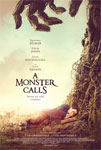Lewis MacDougall A Monster Calls
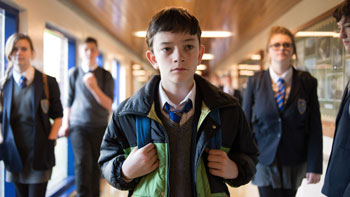
Lewis MacDougall A Monster Calls
Cast: Lewis MacDougall, Liam Neeson, Sigourney Weaver, Felicity Jones, Toby Kebbell, Geraldine Chaplin
Director: J.A. Bayona
Genre: Drama, Fantasy
Rated: PG
Running Time: 108 minutes
Synopsis: Stories are the wildest things of all. – The Monster Directed by J.A. Bayona (The Impossible, The Orphanage), A Monster Calls is a visually spectacular and stunningly emotional drama based on the award winning novel. The screenplay adaptation is by the book's author, Patrick Ness. Ness wrote the novel from an original idea by the late Siobhan Dowd.
12-year-old Conor O'Malley (Lewis MacDougall) is about to escape into a fantastical world of monsters and fairy tales. He is dealing with his mother's (Felicity Jones) illness, which has necessitated Conor's spending time with his less-than-sympathetic grandmother (Sigourney Weaver). His daily existence at his UK school is one of academic disinterest and bullying by classmates. As Conor's father (Toby Kebbell) has resettled thousands of miles away in the US, the boy yearns for guidance.
He unexpectedly summons a most unlikely ally, who bursts forth with terrifying grandeur from an ancient towering yew tree and the powerful earth below it: a 40-foot-high colossus of a creature (portrayed in performance-capture and voiceover by Liam Neeson) who appears at Conor's bedroom window at 12:07 one night – and at that time on nights thereafter. The Monster has stories to tell, and he insists that Conor hear them and powerfully visualise them. Conor's fear gives way to feistiness and then to looking within; for The Monster demands that once the tales are told it will be time for Conor to tell his own story in return. Ancient, wild, and relentless, the Monster guides Conor on a journey of courage, faith and truth.
A Monster Calls
Release Date: July 27th, 2017
Trailer
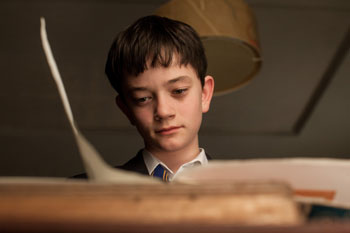 About The Production
About The Production
A Monster Calls began with the book A Monster Calls, first published in 2011.
Sergio Sánchez, a voracious reader, and also the screenwriter of The Orphanage and The Impossible, was so entranced by the novel that he gave it to those award winning films' director, his friend J.A. Bayona.
Upon reading the book, J.A. Bayona recognised at once 'themes I'd touched on in The Orphanage and The Impossible: characters finding themselves in a very intense situation, with death on the horizon. I saw this as a powerful and important story to tell as a movie – an adventure that anyone can relate to."
Millions of readers agree. The novel, written by Patrick Ness, based on an original idea by the late Siobhan Dowd, has been published in almost 40 languages. A Monster Calls won many prestigious prizes worldwide, including the distinguished Carnegie Medal and, for illustrator Jim Kay, the Kate Greenaway Medal. Bayona marvels, 'It became beloved, and iconic – and I wanted to do it justice."
Belén Atienza, J.A. Bayona's producer on his earlier movies and an executive producer on the multi Oscar winning Pan's Labyrinth, took to the book as well. 'Belén Atienza and I both felt passionate about it," states the director, adding that he 'knew it would be an even bigger challenge than The Impossible."
Belen Atienza muses, 'Like all good books that deal with a big subject, in the end you find that it's truly been speaking to you about a lot of different things. One of the key themes is how we process grief and the loss of loved ones. That's what strikes you in a very direct way when you first read the book, but reading it again you can realise the author is exploring how fantasy is part of us as human beings – and the power it can give us to help deal with life.
Once you start to read it and to hear Conor's voice, the effect is so compelling. The beautiful, delicate jewel of a story stayed with me for months." The story had originated with another author, Siobhan Dowd. She succumbed to cancer soon after starting it. Ness reflects, 'Siobhan Dowd wrote magnificent books, ones that teenagers deeply responded to; A Monster Calls was to have been her fifth. She had an opening; 1,000 words; an idea for a structure; and a few characters."
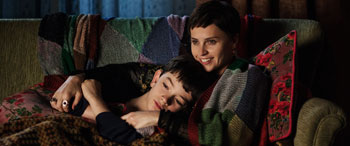 Initially hesitant when approached by the late author's editor and asked to adopt the idea, Ness eventually took on the responsibility. His attachment to the story only grew, and he wanted to ensure that the conversations it encouraged would continue. As such, he wrote a very faithful screenplay adaptation. He explains, 'To me, this is a story about fear of loss. I was really trying above all things to find the truth of how Conor felt; to not lie about it, not sugarcoat it, not sentimentalise it…to really feel how it hurts, because it surely does."
Initially hesitant when approached by the late author's editor and asked to adopt the idea, Ness eventually took on the responsibility. His attachment to the story only grew, and he wanted to ensure that the conversations it encouraged would continue. As such, he wrote a very faithful screenplay adaptation. He explains, 'To me, this is a story about fear of loss. I was really trying above all things to find the truth of how Conor felt; to not lie about it, not sugarcoat it, not sentimentalise it…to really feel how it hurts, because it surely does."
The producer and director sensed that the story could work as a film – without ever losing the emotional core. Belen Atienza notes, 'J.A. Bayona is someone who listens to his emotions. He found a lot of himself in this kid, how Conor accesses fantasy in this difficult point in his life.
Since, in his films, J.A. Bayona likes to speak to audiences through a combination of different genres, this was perfect material for him. He began to see how he might interpret the novel, bringing it -round to his own territory."
The director notes, 'I was also inspired to think about why it is we tell stories, and I began to read up on works of mythology from experts such as Joseph Campbell."
After finishing The Impossible, a film which went on to move audiences around the world, J.A. Bayona received the A Monster Calls screenplay from his agent. Spain's Telecinco Cinema, which had backed J.A. Bayona's earlier films, stepped forward to finance the development and the director knew it would be his next project. Belen Atienza states, 'With the unconditional support of these dear partners, we were able to prepare the movie properly."
Joined by Spain's La Trini, and by the prestigious US based production companies Participant Media and River Road Entertainment, the story was finally headed for the big screen.
'J.A. Bayona and I felt that River Road and Participant understood our creative goals, and this story, from the very beginning," remarks Belen Atienza. 'They realised that we wanted the movie to be a meaningful experience, something you think about afterwards, for a wide audience."
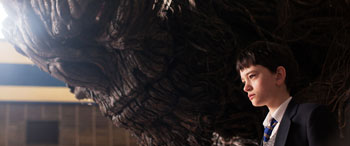 J.A. Bayona and Ness began meeting in Barcelona. 'J.A. Bayona spoke of how A Monster Calls could for him complete a trilogy about mothers and sons," remembers the author. 'I could see that he was the ideal storyteller for this tale. One thing I like about him, which is probably the most important thing in all of my own writing, is that he takes the feelings of a child seriously. He sees the child as a human being, not as a human being in waiting but as someone who truly lives and experiences and feels pain, joy, fear, trust issues and happiness."
J.A. Bayona and Ness began meeting in Barcelona. 'J.A. Bayona spoke of how A Monster Calls could for him complete a trilogy about mothers and sons," remembers the author. 'I could see that he was the ideal storyteller for this tale. One thing I like about him, which is probably the most important thing in all of my own writing, is that he takes the feelings of a child seriously. He sees the child as a human being, not as a human being in waiting but as someone who truly lives and experiences and feels pain, joy, fear, trust issues and happiness."
The two took time to work out details of taking the book from page to screen. 'We didn't want to make a melodrama," states J.A. Bayona. 'Everything had to be integrated: Conor's diverging relationships with his mother and his grandmother, and the fantastical element of the story. I realised that the 40-foot-high Monster would need to be depicted by integrating 2D and 3D animation."
'One other thing that unlocked it for me was the idea that Conor loves to draw; it connected everything else. This was also a bond to me personally, as I was obsessed with drawing when I was a boy."
J.A. Bayona feels that 'the book speaks about death in a direct and darker way. For the film, I wanted to transcend what we know is coming – the death of Conor's mother – and be able to fuse the boy's need to draw with the strength of legacy. There is light at the end of the story, resulting from the idea that art heals. Patrick's screenplay has added themes while still being faithful to the novel; in making the movie, there are some elements of the book that we have taken further."
As usual for the director, prep work encompassed everything from concept art to casting calls for children. To take the journey of making A Monster Calls, he invited core creative collaborators along, 'the people who have been critical to the stories I've told – some dating back to film school."
Belen Atienza adds, 'Óscar Faura, our director of photography; our editors Bernat Vilaplana and Jaume Martí; Fernando Velázquez, the composer – this powerful team of ours can meet any technical challenges while also keeping their artists' souls and a sensitivity to the intimacy of the stories that J.A. Bayona tells."
The creative team on A Monster Calls also includes production designer Eugenio Caballero, an Academy Award winner for Pan's Labyrinth who previously collaborated with J.A. Bayona on The Impossible; and costume designer Steven Noble, who previously collaborated with actress Felicity Jones on her Oscar nominated performance in The Theory of Everything. J.A. Bayona marvels, 'I had the finest resources in the form of these collaborators."
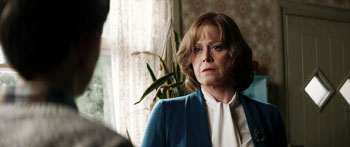 At every phase of pre-production, production and post-production, J.A. Bayona sees Belen Atienza as 'my shadow. She is a constant support, not only in the organisation of the shoot, but creatively as well. Belén Atienza is key to my process. We have tried to bring this novel to the screen in the best and most faithful way possible while at the same time infusing it with our personal vision."
At every phase of pre-production, production and post-production, J.A. Bayona sees Belen Atienza as 'my shadow. She is a constant support, not only in the organisation of the shoot, but creatively as well. Belén Atienza is key to my process. We have tried to bring this novel to the screen in the best and most faithful way possible while at the same time infusing it with our personal vision."
As the project moved forward, it proved difficult to find the right young actor to portray Conor. Atienza notes, 'Conor is in practically every scene of the movie. So we ended up looking at close to 1,000 boys."
Ness was 'worried about how we would ever find somebody who could carry the entire emotional weight of the film, who could take the entire journey of the story."
Late in the casting process, Lewis MacDougall was brought to the production's attention; he had only just finished filming his first movie, Pan. Ness was shown Lewis MacDougall's audition video and saw that 'he was such a find, so true and so focused. You could read everything on that face."
J.A. Bayona agreed, noting that 'in the end there were a couple of very good candidates to play Conor, but we could see that Lewis was able to convey internal conflict. This was important because Conor struggles with a conflict that he is not able to externalise. All told, Lewis MacDougall did an extraordinary audition."
Belen Atienza confirms, 'His first video was magnetic. He has a lot inside, and he's able to bring it out when he needs to. You see so much in his eyes. His way of reacting in scenes is always unexpected. We felt an almost immediate connection with Lewis MacDougall." After a screen test in Barcelona, the role was his.
The project began to attract an impressive adult cast to support the young actor. 'Once I read the script, they had me," says Toby Kebbell, who signed on as Conor's father. 'I had a very emotional response to it. I was thinking about it for days after; even when we're lucky enough to have parents, we all have things we didn't understand about growing up."
Academy Award nominated actress Sigourney Weaver was sought for the role of Conor's maternal grandmother. 'I'm a huge admirer of J.A. Bayona's earlier films; I found them so powerful," she reveals. 'I read Patrick's script and found it to be a haunting and moving story. I felt at once that I would be in good hands with this director who could find the balance between the reality of the situation and the fantasy world that Conor escapes into."
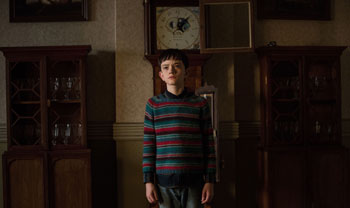 'In both the book and the script, there is a great deal of respect for children; what they experience, what they feel, what they fear. The story doesn't pull its punches, but it is also filled with love."
'In both the book and the script, there is a great deal of respect for children; what they experience, what they feel, what they fear. The story doesn't pull its punches, but it is also filled with love."
Weaver had a clear idea of how to approach her character, and 'A Monster Calls marks my first grandmother role," she muses. 'In the book and in the script, Conor says she doesn't really look like a grandmother, so that was a wonderful place for me to start!
'The grandmother in the book is rather scary," continues Sigourney Weaver. 'I liked the challenge of playing someone who isn't so sympathetic, trying to find the humanity. But at the same time, her point of view is relevant. Conor doesn't really like how different she is from his mother, with all her rules. She is very controlling; being a mother myself, I've been accused of this, so I'm on the grandmother's side and I feel the grandmother is completely right all the time…"
Perhaps most significantly, Weaver took note of how 'the situation takes a toll on my character. What this story shows is how it feels to be losing a member of the family – in her case, her only child – to an illness. Ultimately, her and Conor's relationship grows during the course of the film."
Atienza comments, 'Having never before played a role like this, Sigourney Weaver brings to our story what the character of the grandmother needed: physical power and inner strength, strictness as well as tenderness."
Also crucial to the family dynamic was finding the right actress to portray Weaver's character's daughter, who is MacDougall's character's mother. When J.A. Bayona saw Felicity Jones in her breakout role in Like Crazy – as her Academy Award nominated portrayal in The Theory of Everything had not yet been screened – he knew he had found the actress to play the role. 'I could see in Felicity's screen presence and her acting skills the light that she would bring into this character," he notes.
Belen Atienza clarifies, 'Conor's mom had him when she was 18, and gave up her dreams of becoming an artist. So this mother and son are close in age and therefore have a special connection, a bond of friendship. Our casting Felicity puts that front and centre right away."
Jones took her character to heart. She states, 'Lizzie is a vibrant, active woman who has never stopped loving art. In her home, there are arts and crafts that reveal her creative spirit. She has loved being a mother to Conor, although she's a little unconventional."
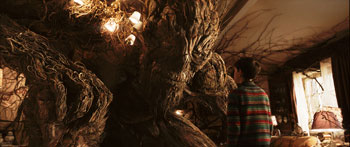 'The fact that she's a single parent – because the relationship with Conor's father has ended – makes the story more powerful because she has formed such an incredible bond with her only child. What's so difficult for Lizzie and Conor is admitting to each other that she is going to die."
'The fact that she's a single parent – because the relationship with Conor's father has ended – makes the story more powerful because she has formed such an incredible bond with her only child. What's so difficult for Lizzie and Conor is admitting to each other that she is going to die."
With the grandmother taking more of an active role in her daughter and grandson's life, Jones reached out to Weaver for extra insight into their characters' dynamic. She offers, 'Sigourney Weaver and I were very keen to find the nuance in the daughter/mother relationship. In many ways, Lizzie is a bit of a rebel. She had Conor when she was young. She's impulsive, and that has sometimes been difficult for her mother. There's a tiny bit of friction between them."
'So what Lizzie wants for Conor is for him to live independently once she is gone; she says to him, -Don't be defined by anyone else.' She hopes that he will be free, because in many ways Lizzie herself has not been. She's never quite been able to find her freedom independently from her mother, so she wants that for her son more than anything; there is enormous love between this mother and daughter, but like any family relationship it has been complicated."
Weaver continues, 'We had rehearsals before we started, and we were able to root around in the scenes and with the relationships. From the very beginning, Felicity and I trusted each other so much that we could play out a huge fight and bring as much reality to it as possible. This mother/daughter relationship is highly emotional, and Felicity brings so much to these scenes."
'You can trust yourself with Felicity, performance-wise," agrees Kebbell. 'She is working as hard as you are to make sure that the scenes between you are authentic."
Weaver adds, 'Each of us, with our own processes, tried to put our all into each of the family scenes. We researched details of the illness and the gradual decline of the body.
Research is sort of like a suitcase; you keep putting things in it. I know it helped me very much. It was very important to all of us to get it right, to tell this story truthfully and with love and respect, especially for those who will see the movie and who have been through this experience with loved ones."
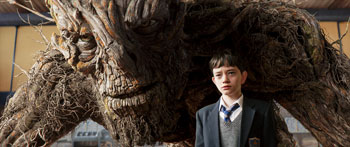 To better portray the family member with the illness, Jones opted to 'visit oncologists because I wanted to get the medical perspective, to know exactly which medications someone would be taking and just how people try and fight the disease."
To better portray the family member with the illness, Jones opted to 'visit oncologists because I wanted to get the medical perspective, to know exactly which medications someone would be taking and just how people try and fight the disease."
'What was incredible was speaking to people who are going through chemotherapy. I met women who were very frank about their experiences and who would take me through the daily rituals of how you cope with something like this. After I had absorbed everything I could, I coordinated efforts with our movie's incredible crew to chart Lizzie's decline."
Bald caps and prosthetics make-up were applied to dramatise the physical effects of the illness taking hold. Working anew with Noble, Jones mapped out how the clothes Lizzie wore might not fit any more because of weight loss – and the actress decided to 'lose weight to show how the cancer was affecting the body. I wanted to convey how her breathing changes, and for us to see her body gradually getting weaker and altering. In reading the script, I identified four specific changes in her physicality, and it became all about trying to show those shifts as subtly and as truthfully as possible."
In one poignant scene, mother and son curl up together to watch the 1933 film King Kong.
The latter classic provided the A Monster Calls filmmakers with a touchstone for how to approach their Monster. For, as Belen Atienza notes, 'It would have been much easier – and, these days, expected – to get that completely computer-generated. We got a fine CG team together, but our feeling is that moviegoers are getting a bit tired of purely CG effects. It feels that much more powerful when you have tangible physicality; that adds warmth and soul to an intimidating creature."
So it was that a practical version of the Monster was built. J.A. Bayona comments, 'This was another way we allied ourselves with King Kong; the giant paw that grabs Conor out of his bedroom, the massive foot he touches, the huge head outside his window – they are all real, including handcrafting work. There is nothing that can't be done now in visual effects, so I believe it engages audiences more when you go back to how things were done in the first generations of moviemaking. It means more and better interaction for the actors too."
The animatronic on-set Monster and his moving parts were tasked for special make-up effects creations by Pan's Labyrinth Academy Award winners Montse Ribé and David Martí with their company DDT. The duo mapped everything out in conjunction with J.A. Bayona and Caballero, their fellow Pan's Labyrinth Oscar winner. Over a three month period, over 30 artists and four hydraulics specialists created head and shoulders, arms and hands, and feet. Martí reveals, 'There are hydraulics in the neck so that the head could move – and be operated by one person from behind, using a kind of steering wheel. First the head was sculpted and then we made a mold, copied it and painted it. The head, shoulders, foot, arms, and branches are basically all foam. We had to carve, burn, shape, paint and provide texture to make all the parts of the Monster look treelike. The challenge we set for ourselves was, make it look real but with very basic materials."
J.A. Bayona elaborates, 'We did about 200 drawings of the Monster. The more we had something that looked like fantasy, the less interesting it was for me. Ultimately, we returned to something close to Jim Kay's iconic drawings in the book."
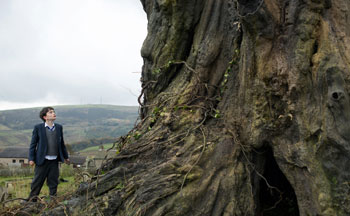 Belen Atienza adds, 'Those drawings by Jim not only inspired the design of the Monster but also encouraged us to personally involve him in the development process, doing some of the preliminary drawings and concept art for the film."
Belen Atienza adds, 'Those drawings by Jim not only inspired the design of the Monster but also encouraged us to personally involve him in the development process, doing some of the preliminary drawings and concept art for the film."
Several visual effects houses created the digital components of the Monster. Postproduction was allocated for a period covering over a year, as 'defining him digitally was complicated," says visual effects supervisor Félix Bergés of the firm El Ranchito, who with special effects supervisor Pau Costa won a Visual Effects Society (VES) Award – honouring Supporting visual effects – for The Impossible. 'He had to have the rigidity and the weight of wood, and move convincingly. We ended up mapping, composing and filming 100 shots of him, interacting with the boy – and it was very challenging!"
Ness reveals, 'The Monster harks back to an English legend called -The Green Man.' He's sort of the landscape personified, rising up to tell stories. He comes from, and is, a great big, powerful force."
'The Monster also represents that part of your personality which you haven't yet come to terms with," adds J.A. Bayona.
As an actor utterly distinct in personality, voice and stature, Liam Neeson was everyone's first choice to portray the Monster, in both voiceover and performance capture. The Academy Award nominated actor was drawn to the story immediately, seeing it as 'a fable about the complexity of our emotions, and navigating that complexity as we grow up."
To provide geographical and environmental context for both the Monster and Conor's family, the filmmakers took as a signpost a description in the second tale the Monster tells: One hundred and fifty years ago this country had become a place of industry. Factories grew up on the landscape like weeds...
So it was that unit production manager Margarita Huguet came to comb the north of England, once the engine of the industrial revolution. She looked for key dramatic locations, including the hill where the yew tree would stand near an ancient church and cemetery.
Belen Atienza recalls, 'Some of the pictures Huguet sent us were from the countryside close to Manchester – absolutely beautiful, with green fields and windy landscapes, cottages and their stone facades, and at the same time echoes of an industrial era in the forms of abandoned factories, huge chimneys and red brick buildings. We thought this region was very beautiful, and just right for the story and the family's history."
The geography of A Monster Calls would span several filming locations, including small towns near Manchester and near Huddersfield, West Yorkshire. The filmmakers found their hilltop at Rivington Pike, near Bolton, Lancashire. The art department, with local help, built and positioned a yew tree to seem as if it had stood for centuries.
A church and cemetery were found together near Delph, also in Lancashire. The patch of land had not been updated or modernized in decades, as there was not a single contemporary gravestone. As the real-life location could only sustain so much activity and visitors, Caballero and Costa supervised a recreation of it as a set on a soundstage in Spain.
In fact, the graveyard's presence in Conor's recurring nightmare necessitated a raised set, built on a platform high above the ground and operated by a hydraulic system. Costa's unit had to rig headstones to fall over, and parts of the earth to break apart and cave in.
Replicas of both church and cemetery were built above and beyond the actual ones' scales.
Caballero notes, 'Those replicas had to be precise, yet data was coming from a computergenerated model. That was one more example of how this project called for a combination of high-end cutting-edge technology alongside very traditional special effects. Our crew rolled up their sleeves to deploy building techniques rarely used now, with molds and plaster, that gave character to the sets."
Belen Atienza praises the finished quality of the setting for the nightmare sequences. She reveals, 'Half of it was shot in the real location, on the top of the hill and in the churchyard; the other half was done at the studio in Barcelona. It all looks of a piece, and is seamless."
The production designer stayed in and around Manchester for as long as he could; he was struck at how the mills, red bricks and Victorian architecture reminded him of the fairy tales illustrated by Arthur Rackham or Edmund Dulac, which he already had in mind while mapping out the fantasy elements of A Monster Calls. This is because, he reveals, 'all of the seeds of the fantasy are planted in Conor's reality. If you look deeply, you will find the shared elements; there are always links between his two worlds. One of this story's core ideas is how fantasy is created out of necessity – and especially out of a need for hope."
'For me, the spaces themselves have to reflect what is happening to the characters and in the story at that moment. Of the two homes in the family, Conor's mother's house is messy and inviting; the palette is colorful, joyful. The grandmother's house is more severe, and everything is in very strict order. Every item has its position, and that frustrates this boy who is used to living in a house where there is freedom." Set decorator Pilar Revuelta, who also won an Oscar for Pan's Labyrinth, knew exactly how to make Conor feel even more ill at ease at his grandmother's home. Caballero elaborates, 'Pilar Revuelta and our teams used dull colors in that house and made its interior sets a little bigger than normal, to make him look smaller. A lot of straight lines and angles were layered in, which creates a certain hostility towards – and in – him.
'For his own home, we did the exact opposite; everything is rounded so that you feel the house is embracing him." The stone exterior of Conor's home, with its overgrown backyard where he sits with the Monster, was created on a parking lot at the Spain studios. The greens team erased any trace of autos residue, planting tall grass brought over from England for the full overgrown effect. A wooden shed and furniture were built, then weathered and aged accordingly.
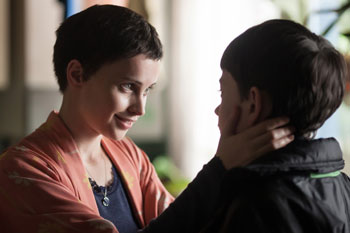 Being from England herself, Jones praises the sets as being 'so right. I was overawed; there was not a single item or dressing or doorway that didn't look entirely English. All the little nuances were there, reflecting how Lizzie does not live materialistically. It would be a bit strange when we would arrive at the studio amidst beautiful, clear blue Barcelona skies – and then step onto a soundstage and be mired in a dreary day in the north of England!"
Being from England herself, Jones praises the sets as being 'so right. I was overawed; there was not a single item or dressing or doorway that didn't look entirely English. All the little nuances were there, reflecting how Lizzie does not live materialistically. It would be a bit strange when we would arrive at the studio amidst beautiful, clear blue Barcelona skies – and then step onto a soundstage and be mired in a dreary day in the north of England!"
Another surprise for the actors, if not for the returning crew, was how much the director likes to move the camera, which meant that sets had to be designed to be as versatile and as flexible as possible. 'J.A. Bayona wants to tell the story with a camera," says Belen Atienza. 'He has the ability to create emotion with the camerawork. The movement and framing are so important; for him, the camera is speaking all the time – in the language of film."
To give J.A. Bayona the freedom to use the camera on a crane, walls of sets were folded on rails or opened like doors. This allowed the camera to see whatever and wherever it could, and allowed Caballero and Revuelta's unit to fill Conor's room with interesting objects until it was nearly bursting at the seams.
Such adaptability meant the sets could be lit with a richness that would not have been possible in natural interiors. In pre-production, director of photography Óscar Faura planned out a lighting design for all the sets so that they were always rigged and ready to go, enabling he and J.A. Bayona to move the camera from one to another at any time.
J.A. Bayona remarks, 'We did do a huge amount of preparation, which was absolutely essential on a film as technically complicated as this one was. It was fascinating to see the lighting on the interior sets, where the very particular kind of light that you get in Manchester was recaptured and recreated. Even those looking carefully will not be able to differentiate between what was filmed indoors near Barcelona and what was filmed in Manchester." The director reflects, 'On A Monster Calls, what I discussed most with Óscar was how this story should be very much anchored in reality. From the first days of filming, Óscar would find exactly the right atmosphere, the right level of darkness or light for each sequence. We've made three movies together now, and I still don't know how he does it. He has the instincts of the old-school cinematographers who created great cinema."
'I think we work together so well because I'm the kind of director who is always looking for the accident, something unexpected that comes out of improvisation – and Óscar is just the opposite; he likes to have everything really locked down. So he keeps my feet closer to the ground while I encourage him to be more daring and to take more risks. I'm proud of what we have achieved on A Monster Calls; visually, this is the most beautiful of the films Belen Atienza muses that 'the connection among J.A. Bayona, Caballero and Faura has only grown stronger since The Impossible. Each one makes the other better as together they create something wonderful."
Caballero notes, 'I feel a lot of freedom working with J.A. Bayona, because we trust each other. The important thing is always, -What do we want to convey, what do we want to make people feel?' We seek to achieve an emotional response. J.A. Bayona has this ability to bring emotions onto the screen. It is a gift."
As A Monster Calls is a deeply felt story, J. A. Bayona applied any number of techniques to make sure that his actors remained in touch with their characters' emotions.
On most days, indelible movie music could be heard on the set in order to evoke a mood; Ennio Morricone and Jerry Goldsmith scores were among the director's favorites on this shoot. He allowed the camera to keep rolling through multiple takes, without the interruption of a clapperboard or shouts of 'Action!" or 'Cut!" Felicity Jones says, 'Having someone shout -Action!' just as you are about to do a crying scene doesn't always put you in the best frame of mind. That's only one way in which J.A. Bayona makes it possible for you to find the emotional depth of the scene and your character. You're not thinking, -Where's the camera?' You're not thinking outside of yourself; you become more and more inside the character, which is what he is trying to achieve with you. It's a very special experience, working with him."
'As a director, he engaged me a great deal," says Toby Kebbell. 'I felt the human connection with him, and with the other actors."
'J.A. Bayona is a real cinema talent," states Liam Neeson. 'Occasionally you get to work with directors who are steeped in the love of what they do, and J.A. Bayona is one of those. He eats, sleeps, and drinks movies. He's a walking film encyclopedia. He's a bit like Martin Scorsese in that way. He's also very sensitive. He takes care of, guides and nurtures his actors and that's what I always hope a director will do. He allows you to experiment, so you both can get at the truth of what a scene is – and he will try for as long as it takes. I love working with a director like that."
As part of J.A. Bayona's approach, Liam Neeson worked alongside Lewis MacDougall so that both actors could share ownership of their scenes together. Liam Neeson reflects, 'I've worked with children who've been swamped by the industry, and they've lost a kind of childlike innocence. Lewis has all that intact. He's still a real kid – but also a powerful young actor."
The young actor – who was 12 years old, the age of his character, at the time of filming – faced a wide range of performance challenges on A Monster Calls, including having an acting partner working in performance capture. Lewis MacDougall offers, 'That was quite difficult because of how technical it was. I would be standing at one end of the room and Liam would be standing at the other end. On-screen it is made to look as if I were standing right in front of him. But he was right there for me in every scene we could have together."
However, for the even more ambitious outdoors sequences, Lewis MacDougall more often had to perform opposite an animatronic puppet incarnation of the Monster – and sometimes opposite no more than a marker. The nightmare sequences necessitated his wearing a harness and abseiling ropes and being protected by a stunt team – during several days of filming in cold and wet conditions.
'I have so much admiration for Lewis MacDougall, working long hours and being in basically every scene," praises Sigourney Weaver. 'First of all, he's so talented. He's also a trouper, and a professional. The role of Conor is a very demanding one, physically and emotionally. Lewis was so courageous, so present, so truthful. I've really learned a lot about acting from Lewis, because he's very much in the moment."
'Lewis was already hugely talented when we started to shoot with him," says Belén Atienza. 'He had very good instincts, and he learned throughout the process to get where he needed to be in a more direct way. We've seen him grow in front of our eyes, in every respect."
J.A. Bayona states, 'Lewis MacDougall was the perfect actor to play Conor. He has a wonderful vulnerability and at the same time a great strength that goes beyond his years, and a lot of that is echoed in the character. He can be compared to an adult actor because he has an amazing ability to prepare himself for a scene."
'In the hospital scene with Felicity, he did a couple of takes where he was caught between wanting to be strong for his mother and feeling grief for himself. Watching him act out that scene was absolutely breathtaking. He is in this incredible struggle, and you can see all the emotion across his face."
Lewis MacDougall says, 'What was great about working with J.A. Bayona is how he would always push me to do better, and then at the end of every scene he'd always giving me a hug and say -Thank you.''"
The director chose not to give his young lead the script page for the very last scene in A Monster Calls, so that Lewis MacDougall would be able to convey the most natural, authentic response as the events unfolded. 'And that's just what Lewis MacDougall gifted us with," says J.A. Bayona.
A Monster Calls
Release Date: July 27th, 2017
Trailer
Have You Seen This?
MORE


